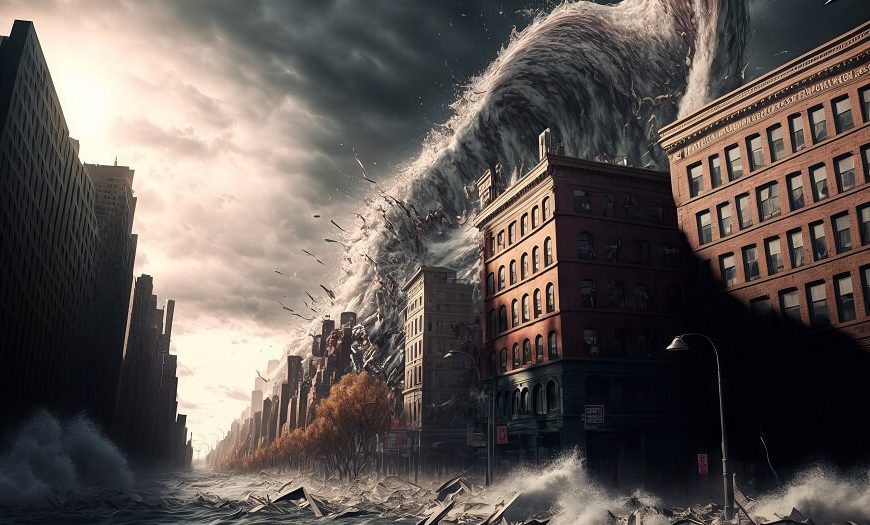Watching a Tsunami on an IMAX screen will undoubtedly make for one of the most thrilling cinematic experiences.
Place that giant wave on a beach you are walking on in real life, and it makes for a Horror Story!
In reality, the risk of a Tsunami is very ‘Real’. There is absolutely no denying the havoc it can wreak.
It was on December 22nd, 2015, that the United Nations passed a resolution designating November 5th as ‘World Tsunami Awareness Day.’ While tsunamis are extremely rare, it must be noted that they are one of the most devastating natural disasters. What’s more, contrary to popular belief, the damage caused by a tsunami is not merely limited to coastal communities!
Are you ready to surf the Wave of some really cool Tsunami Information? Let’s begin, with a look at what are the main causes of Tsunamis.
Tsunamis: Why they happen
The following are the 3 main causes of Tsunamis.
Earthquakes
The leading cause of a tsunami is an Earthquake on the floor of the Ocean.
The sudden movement of giant slabs of rocks against each other, causes the overlying water to move.
Landslides
Believe it or not, landslides are not merely confined to ‘land!’
In an underwater landslide, a large mass of sand, gravel and mud moves down a continental slope. The result? The water that is drawn down might cause a tsunami that travels across the ocean!
Volcanic Eruptions
This is a less common reason for a tsunami. These eruptions can occur in the following ways:
- Pyroclastic flows. These are essentially dense mixtures of things like pumice, ash and gas, that descend down volcanic slopes and into the ocean. The resultant ‘pushing outwards of water’ might be the cause of that tsunami.
- A caldera volcano collapsed. This might happen after it erupts, leading to a sudden drop in the overlying water.
Tsunami Information: Getting Up Close and Personal with Tsunamis
The word Tsunami is pronounced as ‘Tsoo-nah’-mee.’
When one speaks about a Tsunami, the first image that comes to mind is that of ‘One’ Giant Wave. The reality, however, is a tad different.
A tsunami is really a ‘Series’ of large waves. These waves have physical characteristics that are different to those of tidal waves. Moreover, a tsunami wave is totally unrelated to the astronomical tides. We know these tides, of course, as the ‘High tide’ and ‘Low tide’ that we notice every time we go for a swim in the ocean.
One of the best ways that one can describe a tsunami wave, is by calling it a ‘Wall of Water.’ Did you know that these waves can come every 5 to 60 minutes? What’s more, it is usually not the first wave that is the largest. That might be the second, fourth or even later, wave. After the first wave has flooded inland, it recedes completely, exposing the coastline, before the next wave rushes ashore.
How to respond to a Tsunami Warning
If you are in a Tsunami Hazard Zone, here are the precautions you must take, to protect yourself from the wrath of those monstrous waves.
- Get as far away as you possibly can, from all beaches and waterways.
- Stay updated with the latest information via your cell phone.
- If you are ordered by officials to evacuate, listen to them. This might mean moving as high or far inland as possible.
- Stay outside the hazard zone, until officials tell you it is safe to move back in. Just because the tsunami has passed, it does not mean the danger is over.
- Stay away from all weakened structures, and ensure you avoid fallen power lines.
Some Pretty Cool Tsunami Facts
Looking for some facts of Tsunamis you probably didn’t know about before?
Read on, to know more about those ‘killer waves’ best seen only in the movies!
- A whopping 80 percent of all the tsunamis in the world occur within the Pacific Ocean’s ‘Ring of Fire.’
- Tsunamis have been known to have wavelengths of up to 482 kilometres. This is far more than the 30 meters of regular ocean waves.
- The term ‘Tsunami’ is actually specific to the country that is Japan. It literally means ‘Harbour Wave.’ One of the lesser known facts of Tsunamis, this one.
- The time when a tsunami will occur anywhere in the world, can actually be predicted by scientists. They do this by using calculations, with parameters like the Depth of the water, and the Time that a tsunami-inducing event, such as an Earthquake, occurs.
- The Erosion caused by tsunamis can be severe. This includes not only the sand that has taken years to form on beaches, but also the trees and coastal vegetation nearby.
- Tsunamis have been observed even ages ago in the history of civilization. In fact, the very first known reference to a tsunami dates back to the year 426 B.C. We see this when the Greek historian Thucydides refers to it in the book ‘History of the Peloponnesian War.’
- On average, the island of Hawaii gets one tsunami every year, and a severe one every 7 years! The biggest tsunami to have been recorded in Hawaii took place in the year 1946. This was the time when the coast of Hilo island was hit with waves that were 30 feet high, and moving at 500 mph.
- The count of people that were injured in the 2004 Indian Ocean Tsunami, went over 500,000. What’s more, up to 5 million people lost their homes, or their access to food and drinking water.
- The biggest tsunami wave that was ever recorded, took place on July 9, 1958 in the southeast of Alaska. It was an unimaginable size of 1720 feet!
At EuroKids, we encourage you to teach your children all you possibly can, about the dangers of Tsunamis. They must know what fundamental safety precautions to take in case a tsunami warning is issued. When they are made aware of tsunamis, it will only serve to humble them in the face of Nature’s sheer force.















